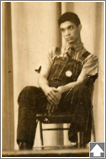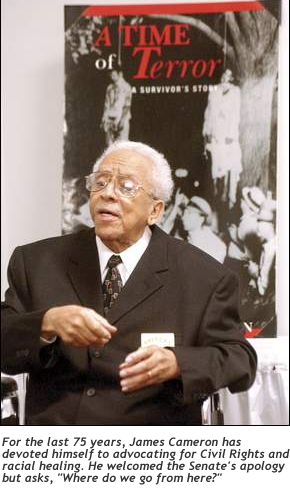MACON HISTORY
Macon Progress Logo Pictures
Osceola

Born a Creek, in Macon County, Alabama, Osceola helped to organize the Seminoles in Florida. He was one of the main figures in both the First and Second Seminole Wars. His father is buried in Franklin, Alabama.
Lewis Adams

Lewis Adams was raised on a plantation, learning several trades and how to read and write. He spoke several languages. He was a tinsmith and attended Butler Chapel A.M.E. Zion Church. He and his wife had 19 children. They taught classes at Butler in the evening. He taught the men, she taught the ladies. Adams joined a white businessman, George Campbell, who lived across from Butler, and brought Booker T. Washington to found Tuskegee Normal and Industrial School, now Tuskegee University. The first degree awarded was to his daughter.
Dr. Booker T. Washington

Booker T. Washington established Tuskegee Normal and Industrial School at Butler Chapel A.M.E. Zion Church. He purchased a plantation and established a large campus featuring Greek and Roman architecture. He established the community of Greenwood, completely "colored" operated with it's own downtown and neighborhoods. He had detailed records of all lynchings and racial injustice. His students established several other schools including: Grambling College. His friends included the wealthiest of the time including Huntingdon and John D. Rockerfeller. He worked with his friend Julius Rosenwald, head of the Sears empire, and helped establish hundreds of schools for colored youth, throughout the U.S.
Dr. George Washington Carver

Carver came to Tuskegee in 1896, at the request of Booker T. Washington. He established research in Pine, Sweet Potato and later Peanuts, which transformed the Southern economy. Creating paint from clay soil and medicine from food crops, his legacy shaped new forms of research. Originally an artist, Carver was a great teacher. He taught science even in his Sunday school lessons, in Tuskegee's Carnegie Hall. He established the mobile school, later called the "Jessup Wagon" to teach farmers in their homes and fields.
Zora Neale Hurston

The author of "Their Eyes were Watching God" and many more, was born in Notasulga, AL. Her father later moved the family to Eaton, Florida, where she was most known. Hurston was a major artist in the Harlem Renaissance.
Gen. Daniel "Chappie" James

Daniel "Chappie" James a well known Tuskegee Airman, fought in Korea and Viet Nam. He became the first black four (4) star General and one of the top military commanders in the Pentagon.
Samuel Leamon Younge Jr.

Sammy Younge grew up in Tuskegee and joined the Navy. After a medical discharge, Sammy attended Tuskegee Institute. He joined the Tuskegee Advancement League and later the Student Non-Violent Coordinating Committee under Stokley Carmichael. He worked to help negros registered to vote. He was murdered behind the Tuskegee bus station with several witnesses, however no one has ever been convicted of Sammy's death. Sammy was the first college student killed in the Black Revolution.
Dr. Charles G. Gomillion

Dr. Gomillion was an instructor at Tuskegee Institute. He organized the Tuskegee Civic Association and was it's leader. When negroes began registering to vote and educated on voting, the elected officials redrew the voting districts to restrict negro votes from being a part of the election process. Lines were drawn down the middle of streets and even separating neighbors. Tuskegee Institute was completely removed from the voting district. Gomillion took the case to court with the famous "Gomillion versus Lightfoote". This reached the Supreme Court and proved the injustice of the redrawn lines. Gomillion also established the longest boycott in Alabama history, to fight injustice. He told everyone to "Shop with your Friends". The businesses practicing racism suffered and others thrived. They tried to take him to court on the boycott, but the judge found nothing wrong with the statement. Over 75% of the downtown businesses failed during the four (4) years of boycott.
Macon County: The Rise of Black Run America

Thomas Simpson Woodward
Click here to read Woodward's book on the early day of Macon County, Alabama. |
In 1832, Thomas Simpson Woodward founded the County, selected Tuskegee as the County Seat, layed out the town square, then built the first house on a ridge near downtown. The history of Macon County, Alabama is very rich. From the Creek nation and their off springs, better known as the Seminoles, with their mighty warrior Osceola, who was born in eastern Macon County, to Ed Varner, a wounded soldier that saved Tuskegee from being destroyed.
Then there was the establishment of the Tuskegee Normal and Industrial Institute, at Butler Chapel A.M.E. Zion Church. This later became Tuskegee Institute and now Tuskegee University. This was the dream of both a black man and a white man. Lewis Adams, the tinsmith and businessman, along with George Campbell, the Tuskegee businessman that saw all people as equal. There was the greatness of both Dr. Booker T. Washington and Dr. George Washington Carver. However, there was also Thomas Campbell, the first black U.S. Extension Agent, and 4 star General Daniel "Chappie" James, Chief Anderson, Benjamin O. Davis, Jr. and the Tuskegee Airmen. Their adventures in the European Theater began at Moton Field, then Shaw Field, both in Macon County. The famous author Zora Neale Hurston was born in Notasulga. Rosa McCauley as born and raised in Tuskegee, to later become Rosa Parks. The great Olympic athlete Alice Coachman was trained and first competed on the tracks of Tuskegee Institute. The incredible swimmer, Palmer Sullins, first swam in Logan Hall's pool, on the campus of Tuskegee Institute. The famous landmark court case, "Gomillion versus Lightfoote", began in Macon County and ended in the Supreme Court. Sammy L. Younge, Jr. grew up and went to school in Tuskegee and later attended Tuskegee Institute, before he was gunned down fighting for voter's rights and equality for all. And the Commodores with Lionel Richie, were first the Mystics and Jays in Tuskegee. Learn about these and more as you read what happened in Macon County, and with the people and events of Macon County, Alabama. U.S. Senate Lynching Apology
Tuskegee Institute documented the lynchings in the United States of America in it's Negro Almanac. The following is an article composed by Professor Kim on the United States Senate Apology concerning it's non-action on lynching:
BEHIND THE SENATE'S LYNCHING APOLOGY UPDATE On NPR, historian John Hope Franklin explains why the Senate's apology is too little, too late. Last night, the US Senate passed a resolution apologizing for that body's failure to act against lynching, a practice that, between 1882 and 1960 alone robbed nearly 5,000 American citizens of their lives without due process of law, according to statistics compiled by Tuskegee University. While the resolution was passed by unanimous consent, its handling suggest that at least in some sections of the country, the acknowledgement of this shameful episode is still politically sensitive. About 75 percent of the victims were black and most were men, but women and children were sometimes executed as well. (The website devoted to the official report on the grisly 1921 Tulsa race riots -- a mass lynching if there ever was one -- includes the horrific picture of a black mother and son suspended from a bridge, while a crowd of white onlookers celebrates.) Other lynching victims included white abolitionists and civil rights workers, and others of a variety of ethnic backgrounds. The actual death toll from lynching is higher than the Tuskegee count because the practice began well before the 1880s and lasted at least into the 1980s. Most lynchings were acts of economic terrorism. Prof. William Jelani Cobb presents a concise and authoritative history here. About 200 descendants of lynching victims were on hand to commemorate the passage of the resolution, along with the bill's sponsors Sens. Mary Landrieu (D-LA) and George Allen (R-VA). Also on hand was James Cameron,, 91, believed to be the only man to survive a lynching. On the night of Aug. 7, 1930, Cameron, then 16, was beaten and strung up alongside his friends Abram Smith, 19 and Thomas Shipp, 18, after the trio was accused of murdering a white man a raping his female companion in Marion, Indiana. Cameron admits to participating a robbery attempt, but says that he panicked and ran away when he realized that he recognized the intended victim. His friends were killed, but as the noose was being tightened around Cameron's neck, a voice called out, "Take this boy back. He had nothing to do with this." The photograph of Shipp and Abram hanging from a tree while a mob celebrates below inspired Abel Meerpool to write the poem "Strange Fruit", later immortalized in song by Billie Holiday. The resolution had 78 cosponsors from across the political spectrum and most regions of the country. While all of the survivors who spoke to reporters welcomed the apology, some had their dowbts about its substance and sincerity. Magdalene Latimer, 84, whose forbear Anthony Crawford was slaughtered in 1916 because of a land dispute with a white man, told the New York Times "I have to let God be the judge, because I don't know if they meant it out of their heart or they're just saying it out of their mouth." Indeed, the New York Times reported that the reason that the vote was taken as a voice vote and not by roll call was to avoid embarassing some Senators. That reportedly included sponsor George Allen, who has been chided for keeping a confederate flag and a lynchman's noose in his office -- items he says are mere historical artifacts. Allen also reportedly opposed the Martin Luther King, Jr. holiday and, as governor, signed a bill celebrating Confederate Heritage Month. Sen. John Kerry was blunt: "I am personally struck, even at this significant moment, by the undeniable and inescapable reality that there aren't 100 senators and co-sponsors. Maybe by the end of the evening there will be, but as we stand here with this resolution now passed by voice vote, there aren't." There weren't, and so far, only a few Senators appear to have commented on their reasons for not signing on. I have begun collecting those responses, and I have begun e-mailing those Senators whose responses have not appeared in print. So far, this is the list of non-signers, by my count. What does it mean if this many Senators can't sign on to even a symbolic attempt at Truth and Reconciliation? Alexander, Lamar- (R - TN) Bennett, Robert- (R - UT) Bingaman, Jeff- (D - NM) Cochran, Thad (R-MS) Conrad, Kent D-ND) Cornyn, John (R-TX) Enzi, Michael (R-WY) Grassley, Chuck (R-IA) Gregg, Judd (R-NH) Hatch, Orrin R-UT) Hutchinson, Kay (R-TX) Kyl, Jon (R-AZ): "Says he doesn't endorse "sense of the Senate" resolutions but agrees with apology Lott, Trent (R-MS) Murkowski, Lisa (R-AK) Sessions, Jeff (R-AL): Press secretary says "Sessions doesn't endorse everything that crosses his desk" Shelby, Richard (R-AL): says he doesn't remember being asked Sununu, John (R-NH) Thomas, Craig (R-WV) Voinivich, George (R-OH) Posted by Professor Kim at 12:37 PM 06/14/05 |



